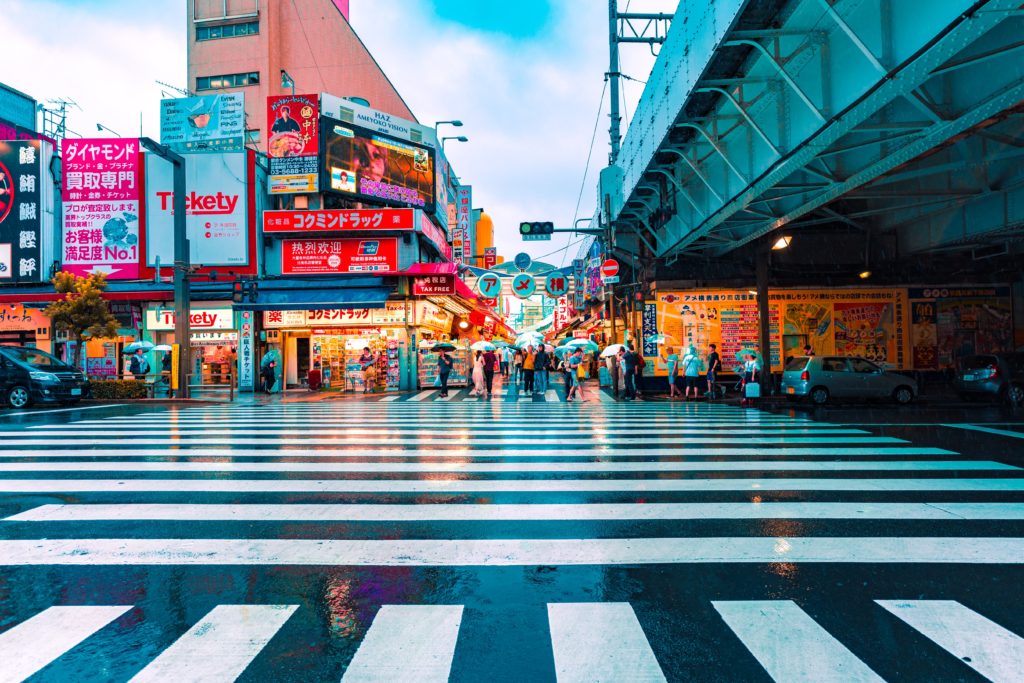Jing-We, my contact in the community, had promised to take us to eat Zainichi Korean cuisine. I follow her down narrow alleys lit with bright neon signs that twist and turn so much that I am not sure I can find my way out of the maze. We finally reach our destination: a wooden building under the train tracks with small windows stained with years of smoke. Inside, the place is loud and cramped—the sort of place I enjoy but terrible for a conversation. Jing-We introduced the owner behind the small grill station. Her daughter is sort of a local celebrity as she plays for the North Korean national soccer team.
Back at the table, Jing-We orders grilled beef heart and stomach, pork ear and rice dumpling soup (tteokguk). I follow Jing-We’s lead and dig into the food. The dishes present the full spectrum of texture ranging from chewy to crunchy and pair well with alcohol. At the next table, a pair of Australian tourists take a seat looking out of place in a restaurant that rarely hosts outsiders. They ask for vegetarian options and the owner is at a loss for words. The tourists leave disappointed they could not have a taste of what they assumed was Korean cuisine.

The Cuisine of Zainichi Koreans
I spent the next few months exploring food in Osaka’s Koreatown. The social and economic life of the neighborhood revolves around food. Yakiniku, or grilled meat, restaurants are a common sight in this neighborhood. Originally, these restaurants used to serve grilled organ meat that would be discarded otherwise. As restaurant owners grew more affluent, they began to serve more expensive cuts of meat. Yakiniku restaurants began as smoky drinking joints which then became a family fare in part due to the invention of the smokeless grill, a vacuum chimney that hovers over tables.
Kimchi stands also scatter the neighborhood. Zainichi Koreans had to find creative ways to make kimchi adapted to the taste of local consumers with, for example, seaweed kimchi and tomato kimchi. Although kimchi is sometimes used as an ethnic slur in Japan, it is today one of the most popular pickles in Japanese. The sweeter less fermented Japanese version called kimuchi has in recent years sparked more than one controversy between Japan and Korea. Another noteworthy feature of Koreatown are scallion pancakes (chijimi) available as street food. With time, the term chijimi remains in use only among Korean descendants in Japan. These Korean style pancakes are most likely the precursor of okonomiyaki, Osaka’s most famous food.

Japanese and Korean influences
The food developed by Zainichi Koreans is not Japanese but it is not fully Korean either. This food had to adapt to available ingredients and consumer preferences in Japan. Zainichi Korean entrepreneurs and home cooks turned these dishes into something uniquely Korean-Japanese. By adapting their food to the Japanese palate, Zainichi Koreans transformed Japanese society and culture from within. Some dishes introduced by Zainichi Koreans became widely accepted in Japan.
For example, today, spicy pollock roe (karashi mentaiko) is a specialty of Fukuoka, a city with a large Korean population. Korean style raw steak (yukke) is a common item in restaurants in Japan. Some of the dishes introduced by Zainichi Koreans are not considered foreign any longer in Japan. Yakiniku is the most popular food among young Japanese who for the most part consider it native to Japan. This raises the problem of appropriation of Korean food in Japan I have discussed in an article here.

Who has the right to a Cuisine?
A cuisine is a collection of dishes that represent the food practices of a country or a region. Cuisine is a symbol. Strategic decisions are made on what to include and what to exclude in a given cuisine. More often than not, inhabitants of a given country or region do not consume this food regularly. The question of ownership might appear as senseless when culinary borrowing is the norm. However, for marginalized minorities, food ownership matters. First, it is a very real source of revenue for communities. Second, the lack of recognition runs the risk of erasing minority contributions.
Why is Korean-Japanese food not recognized as a cuisine in its own right? This has more to do with power–influence, resources, visibility–than not having a food culture. A drawback of not having a cuisine is that established cuisines can “poach” dishes created by minority communities. With that in mind, kimchi, yakiniku or chijimi made by Koreans in Japan is neither Korean cuisine nor Japanese cuisine. It is Zainichi Korean cuisine. A cuisine born out of struggles and creativity.


Fantastic web site. A lot of helpful info here. I am sending it to several buddies ans additionally
sharing in delicious. And naturally, thank you on your sweat!
My website :: Royal CBD